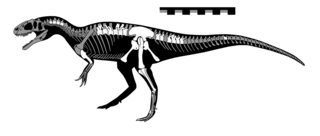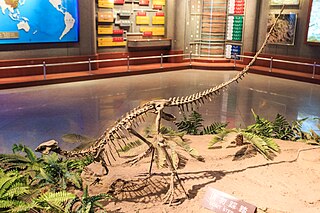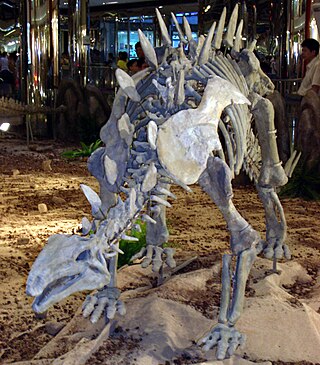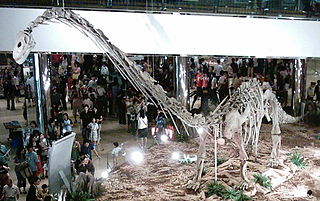
Mamenchisaurus is a genus of sauropod dinosaur known for their remarkably long necks which made up nearly half the total body length. Numerous species have been assigned to the genus; however, the validity of these assignments has been questioned. Fossils have been found in the Sichuan Basin and Yunnan Province in China. Several species from the Upper Shaximiao Formation, whose geologic age is uncertain, have been described. However, evidence suggests this formation to be no earlier than the Oxfordian stage of the Late Jurassic. M. sinocanadorum dates to the Oxfordian stage, and M. anyuensis to the Aptian stage of the Early Cretaceous. Most species were medium-large to large sauropods, measuring roughly 15 to 26 meters in length—possibly up to 35 meters (115 ft), based on two undescribed vertebrae.

Gasosaurus is a genus of tetanuran theropod that lived approximately 171.6 to 161.2 million years ago during the middle of the Jurassic Period. The name "Gasosaurus" is derived from the English "gasoline" and the Greek σαῦρος. Only one species is currently recognised, G. constructus, from which the specific name honours the gasoline company that found the Dashanpu fossil quarry in Sichuan Province, China, now named as the Lower Shaximiao Formation.

Yangchuanosaurus is an extinct genus of metriacanthosaurid theropod dinosaur that lived in China from the Middle Jurassic to Early Cretaceous periods, and was similar in size and appearance to its North American and European relative, Allosaurus. Yangchuanosaurus hails from the Upper Shaximiao Formation and Suining Formation and was the largest predator in a landscape that included the sauropods Mamenchisaurus and Omeisaurus and the stegosaurs Chialingosaurus, Tuojiangosaurus and Chungkingosaurus. This theropod was named after the area in which was discovered, Yongchuan, in China.

Agilisaurus is a genus of ornithischian dinosaur from the Middle Jurassic Period of what is now eastern Asia. It was about 3.5–4 ft long, 2 ft in height and 40 kg in weight.

Shunosaurus, meaning "Lizard from Sichuan", is a genus of sauropod dinosaur from Late Jurassic (Oxfordian) beds in Sichuan Province in China, from 161 to 157 Million years ago. The name derives from "Shu", an ancient name for the Sichuan province.

Huayangosaurus is a genus of stegosaurian dinosaur from the Middle Jurassic of China. The name derives from "Huayang" (華陽), an alternate name for Sichuan, and "saurus", meaning "lizard". It lived during the Bathonian to Callovian stages, around 165 million years ago, some 20 million years before its famous relative, Stegosaurus appeared in North America. At only approximately 4 metres (13 ft) long, it was also much smaller than its famous cousin. Found in the Lower Shaximiao Formation, Huayangosaurus shared the local Middle Jurassic landscape with the sauropods Shunosaurus, Datousaurus, Omeisaurus and Protognathosaurus, the ornithopod Xiaosaurus and the carnivorous Gasosaurus.

Tuojiangosaurus is a genus of herbivorous stegosaurian dinosaur from the Late Jurassic Period, recovered from the Upper Shaximiao Formation of what is now Sichuan Province in China.
Zigongosaurus is a genus of sauropod dinosaur from the Middle Jurassic-Late Jurassic-age Shaximiao Formation of Zigong, Sichuan, China. Because of incomplete knowledge of Jurassic Chinese sauropods, it has been hard to interpret, with some sources assigning it to Omeisaurus, some to Mamenchisaurus, and some to its own genus.

Omeisaurus is a genus of sauropod dinosaur from the Middle Jurassic Period of what is now China. Its name comes from Mount Emei, where it was discovered in the lower Shaximiao Formation of Sichuan Province.

Datousaurus was a dinosaur from the Middle Jurassic. It was a sauropod collected from the Lower Shaximiao Formation in Dashanpu, Zigong Sichuan province, China. It shared the local Middle Jurassic landscape with other sauropods such as Shunosaurus, Omeisaurus, Protognathosaurus, the ornithopod Xiaosaurus, the early stegosaur Huayangosaurus as well as the carnivorous Gasosaurus.
Protognathosaurus is a genus of herbivorous dinosaur from the Middle Jurassic. It was a sauropod found at Dashanpu in Sichuan in what is present-day China.
Bashunosaurus is a genus of potentially macronarian sauropod dinosaur from the Middle Jurassic Shaximiao Formation of Kaijiang, China. The type and only species is Bashunosaurus kaijiangensis.
Daanosaurus was a genus of dinosaur. It was a sauropod which lived during the Late Jurassic. It lived in what is now China, and was similar to Bellusaurus.

Gigantspinosaurus is a genus of herbivorous ornithischian dinosaur from the Late Jurassic. It was a stegosaur found in China.

Yingshanosaurus is a genus of stegosaurian dinosaur from the Late Jurassic, around 155 million years ago. It was a herbivore that lived in what is now China. The type species is Yingshanosaurus jichuanensis.

Hexinlusaurus is a genus of basal ornithischian dinosaur from the Middle Jurassic of China.
Dong Zhiming is a Chinese vertebrate paleontologist formerly employed at the Institute of Vertebrate Paleontology and Paleoanthropology (IVPP) in Beijing. He began working at the IVPP in 1962, studying under Yang Zhongjian, who was director at the time. He has described fossil remains of many dinosaurs. He investigated and described the Shaximiao Formation; an important contribution to science since they are composed of Middle Jurassic beds which do not commonly yield fossils.
Dashanpusaurus is an extinct genus of sauropod dinosaur that lived during the middle of the Jurassic period. The dinosaur was described in 2005 by Peng Guangzhao, Ye Yong, Gao Yuhui, Shu Chunkang, and Jiang Shan. Its type and only species is Dashanpusaurus dongi, named in honor of the paleontologist Dong Zhiming.

The Shaximiao Formation is a Middle to Late Jurassic aged geological formation in Sichuan, China, most notable for the wealth of dinosaurs fossils that have been excavated from its strata. The Shaximiao Formation is exposed in and around the small township of Dashanpu, situated seven kilometres north-east from Sichuan's third largest city, Zigong, in the Da'an District.

Bashanosaurus is an extinct genus of stegosaurian dinosaur from the Middle Jurassic Shaximiao Formation of Yunyang County, China. The genus contains a single species, Bashanosaurus primitivus, known from incomplete skeletons belonging to three individuals. It is one of the basalmost stegosaurs, as well as one of the oldest known stegosaurs, along with Adratiklit, Isaberrysaura, and Thyreosaurus.



























